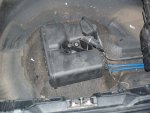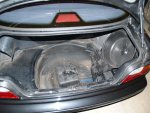Ah, thats your Charcoal or Carbon Canister.
Reason:
Government-mandated emissions standards were put in place in the early ‘70s. Since then, automobiles (including our BMWs) have been subject to even more stringent requirements regarding substances that are released to the atmosphere. While exhaust emissions have gotten the majority of the attention, there are indeed other emissions which have also come under scrutiny and control. The most important of these is the evaporative fumes from the raw (or unburned) gasoline.
Almost all BMWs on the road today have a raw fuel, vapor recovery system. The fuel tank on your BMW needs to vent as the fuel is drawn out and used in the engine. If there were no provision for venting, a vacuum would develop in the tank and soon the fuel pump would not be able to draw the fuel out and deliver it to the engine. In the old days (before the government mandates), car manufacturers handled this with a simple vent tube from the tank to the outside air. Unfortunately, this allowed raw fuel vapors to go directly into the atmosphere. To prevent this, car fuel systems now employ a closed venting system that, in the end, burns the collected fuel vapors in the engine. As with the various other systems on our BMWs, the vapor recovery system requires maintenance. BMWs 1996 and later have rather elaborate systems which include such things as pressure and leak sensors and valves that are monitored by the On Board Diagnostic (OBD) system. The basic system, found on almost all BMWs, consists of the fuel filler cap (gas cap), fuel & vapor separation tank, charcoal canister, purge valve and the associated rubber tubing connecting the system together.
In the vapor recovery system, the gas cap seals the fuel system, the charcoal canister receives and stores the raw fuel vapors, and the purge valve (in the line between the canister and the intake manifold) controls the flow of vapors from the canister to the engine for burning. The gas cap. A faulty gas cap – one that does not close properly, has a missing or damaged seal, etc. – will allow vapors to escape to the atmosphere and will compromise the vapor recovery system. But it can also cause a fuel smell, poor emissions and fuel economy, and possible damage to the fuel pump and pressure regulator. The charcoal canister. Over time, it will become saturated by the fuel vapors and will no longer be able to contain the vapors and fumes. If you have raw fuel smells but can detect no fuel leaks, you may indeed have a saturated charcoal canister. The canister can also become clogged, or plugged, by over-filling the fuel tank. If you (or the prior owner) had been in the habit of filling the fuel right up to the top of the filler neck instead of stopping when the nozzle first clicks off, raw fuel can enter the vapor recovery system and saturate the charcoal. If this happens, the canister must be replaced. A saturated canister not only causes noxious fuel smells and poor fuel economy but, left for a longer period, can cause damage to the fuel pump and fuel pressure regulator.
The purge valve. This valve controls the venting of the stored vapors (in the canister) to the engine (via the intake manifold). Upon command from the Engine Control Unit (ECU), the valve opens and the vapors are drawn into the engine to be burned along with the standard fuel and air mixture. A faulty purge valve that stays open all the time can effectively cause a vacuum leak. If it remains closed all the time, it can cause the same symptoms as a saturated charcoal canister.


